review, pages 6 and 7


review, pages 6 and 7

Illuminating lives one home at a time
PAGES 20-25






This month’s feature is about a program special to all of us at Indiana Electric Cooperatives, the publisher of Indiana Connection.
Project Indiana is an initiative created by Indiana’s electric cooperatives to bring power to underdeveloped countries. In 2012, to celebrate the International Year of the Cooperative, two teams of Indiana cooperative lineworkers spent a month electrifying three villages in Guatemala. Thirteen years later, 16 Indiana lineworkers traveled to Palmira — a mountainous area along the western edge of Guatemala — with the intention to electrify 109 homes. At the end of the two weeks, they exceeded that goal, with 197 homes receiving power.
As Americans, we tend to take electricity for granted. We might complain about it when we feel our monthly bill is too expensive, but we know when we flip a switch or plug something in, the power will be there.
What the team was able to accomplish down in Palmira in such a short amount of time is not only an impressive feat of engineering but will change the lives of the residents. They can now store their food in refrigerators and freezers. They can acquire appliances to cook food safely inside their homes. Even something as simple as having light in the house after the sun goes down is now possible.
Electric cooperatives are governed by seven principles, one of which is “Concern for Community.” Indiana’s cooperatives care about not only the communities close to home but also those much farther away that can benefit from a helping hand. Readily available electricity not only powers the village but also progress and new opportunities.
I encourage you to turn to page 20 and learn more about this amazing trip and the Project Indiana program.


Britt Davis Editor
bdavis@indianaec.org
On the menu: August: Submit your favorite recipes featuring tomatoes, deadline June 1. If we publish your recipe on our food pages, we’ll send you a $10 gift card.
Giveaway: Enter to win a bourbon glass from Zimmerman Art Glass. Visit indianaconnection.org/talk-to-us/contests or send your contact information to the address below. The deadline to enter is May 31.
Three ways to contact us: To send us recipes, photos, letters and entries for gift drawings, please use the forms on our website indianaconnection.org; email info@indianaconnection.org; or send to Indiana Connection, 11805 Pennsylvania Street, Carmel, IN 46032.
VOLUME 74 • NUMBER 11 ISSN 0745-4651 • USPS 262-340
Published monthly by Indiana Electric Cooperatives
Indiana Connection is for and about members of Indiana’s locally-owned, not-for-profit electric cooperatives. It helps consumers use electricity safely and efficiently; understand energy issues; connect with their co-op; and celebrate life in Indiana. Over 311,000 residents and businesses receive the magazine as part of their electric co-op membership. The average printed and mailed cost per issue is 54 cents.
CONTACT US: 11805 Pennsylvania Street Carmel, IN 46032 317-487-2220
info@indianaconnection.org IndianaConnection.org
INDIANA ELECTRIC COOPERATIVES OFFICERS: Steve McMichael President Dr. Richard Leeper Vice President
Jamey Marcum Secretary/Treasurer
John Cassady CEO
EDITORIAL STAFF:
Britt Davis Editor
Mandy Barth Vice President of Communication
Lauren Carman Communication Manager
Ashley Curry Production and Design Coordinator
Holly Huffman Communication Support Specialist
Amber Knight Creative Manager
Kiley Lipps Graphic Designer
ADVERTISING:
American MainStreet Publications Cheryl Solomon, local ad representative; 512-441-5200; amp.coop
Paid advertisements are not endorsements by any electric cooperative or this publication.
UNSOLICITED MATERIAL:
Indiana Connection does not use unsolicited freelance manuscripts or photographs and assumes no responsibility for the safekeeping or return of unsolicited material.
SUBSCRIPTIONS: $12 for individuals not subscribing through participating REMCs/RECs.
CHANGE OF ADDRESS:
If you receive Indiana Connection through your electric co-op membership, report address changes to your local co-op.
POSTAGE:
Periodicals postage paid at Indianapolis, Indiana, and at additional mailing offices.
POSTMASTER: Send change of address to: Indiana Connection, 11805 Pennsylvania Street, Carmel, IN 46032. Include key number.
No portion of Indiana Connection may be reproduced without permission of the editor.




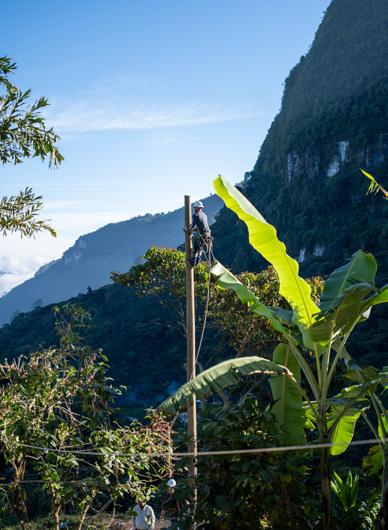
Sixteen Indiana electric cooperative lineworkers traveled to Palmira in late January as part of an international initiative to bring electricity to a developing area in Guatemala. Learn more about this life-changing program in this month’s cover feature.

CONTACT US
Office: 812-482-5454
Billing Dept.: 812-482-1664
Operations Dept.: 812-482-1188
After Hours: 812-482-5455
Fax: 812-482-7015
CEO AND GENERAL MANAGER
Joe Henson
OFFICE HOURS
7 a.m.–4 p.m., Monday-Friday
7 a.m.–3:30 p.m. for Line Dept.
STREET ADDRESS 1400 Energy Drive Jasper, IN 47546
MAILING ADDRESS
P.O. Box 610 Jasper, IN 47547-0610
EMERGENCY POWER OUTAGES
To report service interruptions, call: 812-482-5454 (during regular hours) or 812-482-5455 (after hours) day or night. Please have your account number ready when reporting outages.
BOARD OF DIRECTORS
Brad Knies, President
Richard A. Wendholt, Vice President
Randall L. Stemle, Secretary-Treasurer
Mark Montgomery
Andy Schwenk
Steve Speedy
David Rudolph
KEY STAFF
Craig Adams Manager of Finance
Matt Brames Manager of Engineering
Greg Dilger
Engineering Project Manager
Ruth Hopf
Billing Supervisor
Patrick Lichlyter Manager of Operations
CUSTOMER SERVICES
Budget billing
SmartHub
Pay by phone 24/7 Drive-thru window
Night depository
Medical account watch

When summer heats up, our electric bills tend to increase as air conditioners are working overtime, driving up home energy consumption. Dubois REC is your local not-forprofit electricity provider, and we are committed to helping you beat the heat without breaking the bank.
As the temperatures get hotter over the next few months, we want to make sure you know about a range of energy-saving offerings designed specifically with you in mind. By taking advantage of these programs and services, you can manage your summer energy consumption and costs.
When you sign up for Dubois REC’s Budget Billing plan, your energy bill is calculated by averaging your previous 12 months of use. With this program, your monthly energy costs are easier to budget and manage, especially during seasonal fluctuations when bills tend to increase based on the weather. Budget Billing is a great option for anyone on a fixed income or those with highly variable seasonal needs.
When you make upgrades or purchases to reduce home energy use, those smart decisions should be rewarded. Dubois REC offers rebates and incentives on energy
efficient appliances, heating and cooling equipment and more. Visit our website, duboisrec.com to learn about our rebate programs.
Small actions combined can have a big impact on summer energy bills. The best way to lower energy use during summer months is to raise the thermostat to the highest setting that’s comfortable. Ceiling fans can also help you feel cooler, but remember to turn them off when you leave the room. On warm summer nights, fire up the grill to keep additional heat out of the kitchen. Remember to change air filters often so your cooling system doesn’t have to work harder than necessary.
Don’t let energy bills take a toll on your summer fun. Dubois REC is here to help manage your energy use, whether through efficiency programs and services or energy-saving advice from our local energy advisors.
Contact us to learn more about practical strategies to lower your use, trim your bills and make this summer a breeze for both you and your wallet.

JOE HENSON CEO and General Manager
Service charge
Single-phase
$35.50
Three-phase $47
Energy charge
The first 500 kWh at $.10522 /kWh
The next 2,500 kWh at $.09772/kWh
All remaining kWh at $.09462/kWh
Power cost tracker
All rate classes
All kWh at $0.0039/kWh
Security light
If you have a security light, add:
175-watt mercury vapor
100-watt sodium vapor
100-watt metal halide
$8.32/month
$7.50/month
$8.75/month
70-watt LED ..................................... $7.50/month
Electric bills due by the 20th of each month.
Members who pay by the 15th, or pay their bill by auto draft, will be entered in the monthly drawing for a $50 bill credit.
Visit duboisrec.com for easy ways to pay your electric bill online.
It’s easy to enter our monthly $50 drawing! All Dubois REC members who pay their bill by the 15th of the month, using any payment option, will be automatically entered in the $50 monthly drawing. Members who pay by ACH/bank draft and recurring payments are also automatically included in the drawing. (Delinquent payments are not eligible.)
The winner will be notified, and their name will be published here.
APRIL’S WINNER:
LINDA S. HOCHGESANG, ST. ANTHONY
The Annual Meeting of Dubois REC was held at the Huntingburg Event Center on April 8 at 7 p.m.
Since no petitions for nomination were submitted for the districts up for election, the incumbent directors were officially seated for another three-year term at the 2025 Annual Meeting.
• District 2 - Randall Stemle
• District 7 - Richard Wendholt
Prior to the meeting, members received a registration form in the mail. Members who attended the meeting were entered into the prize drawings. A separate “Early Bird” drawing was held for members unable to attend, but submitted their registration card before the meeting.
Grand Prize, $1,000 gift certificate for electricity:
Alma J. Haas
$750 gift certificate for electricity
Leola M. Heeke
Richard L. Lampert
$500 gift certificate for electricity
Tim M. Gunselman
Robert J. Fleck
Doris J. Haas
Floyd E. Jones
Mark B. Lichlyter
$250 gift certificate for electricity
Linda Eisenhut
Ronald L. Hopf
Steven V. Hopf
James J. Lange
Michael A. Rees
Donald E. Scherle
Rita M. Schroeder
Howard P. Scott
Joe C. Shelton
David U. Spellmeyer
Dean A. Welp
Jeffrey L. Verkamp
PRIZE WINNERS
$100 gift certificate for electricity
Barnyard BBQ Catering, LLC
Kenneth R. Brosmer
James C. Brown
Richard L. Dilly
Jesse T. Hagedorn
Vincent R. Harpenau
Carolyn Harris
Jason M. Hopf
Chad A. Knies
William C. Lakin
Lapetite Beauty Salon
Joseph T. Leonard
Glenn A. Mehringer
Open Window Properties
Donna R. Schwartz
Reyes J. Siddons
Jon J. Watkins
Dwayne A. Weisheit
Farrel J. Weisheit
Terry Werne
All bill credits won at the Annual Meeting will be applied to members’ May electric bills.
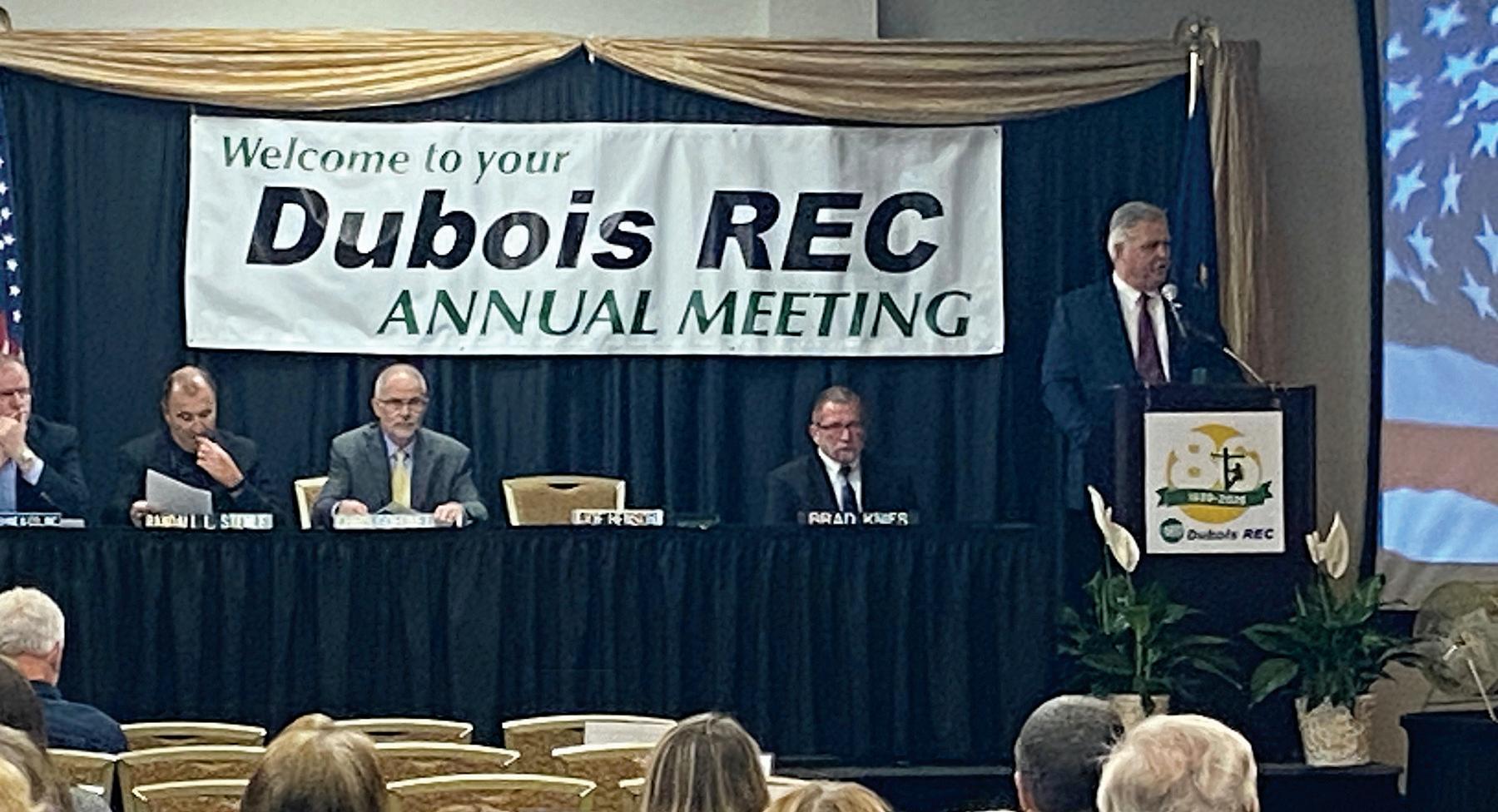




The Dubois REC office will be closed on May 26 in honor of Memorial Day. We remember and honor those who have served our country.
As an electric cooperative, Dubois REC is guided by the Seven Cooperative Principles. The seventh principle is “Concern for Community.” One of the most significant ways Dubois REC helps support local groups and organizations in our community is through our Operation Round Up® program.
Dubois REC members who participate in the program allow their monthly electric bills to be “rounded up” to the next dollar. Participating members contribute around 50 cents per month to the program. That spare change is placed in a community fund, overseen by a volunteer board of trustees.
This volunteer board meets each quarter to review the requests for grants. Local community groups, non-profits, fire departments, school programs and similar organizations can apply. Since 2011, Dubois REC has given $593,822.82 back to the community in the form of member-funded grants.
This month we are pleased to announce Operation Round Up grants were awarded to the following local organizations:
• St. Paul’s Lutheran Church received $5,000 for basement renovations.
• Crawford County Fairgrounds received $2,325 to install a walking path.
• St. Patrick’s Celebration, Inc. received a $1,500 grant to install dusk to dawn safety lighting.
• Breeden Library Foundation, Inc. received a $2,500 grant to install an outdoor park/sitting area.
If your group or organization could benefit from an Operation Round Up grant, visit duboisrec.com and look in the “Community” section for information about the Operation Round Up program.
Download an application, complete it and submit the application along with supporting documents by June 27 to be considered for our next round of community grants.
If you are not currently participating in Operation Round Up, visit our website, duboisrec.com, look in the “Community” section and download an “Opt-In” form to start rounding up your electric bill. You can also call the Dubois REC office to get more info and an application.
Local
Dubois REC will sponsor two students at Camp Kilowatt. The annual camp will be held June 4-7 at Camp Tecumseh in Brookston, Indiana.
Students entering seventh grade in 2025 are eligible to attend and are selected by their local cooperative to participate in the four-day program. The students’ agenda combines traditional outdoor camp activities, electrical safety practices and cooperative business education. Students chosen from the Dubois REC area are Molly Verkamp, a homeschool student from Birdseye and the daughter of Roger and Katie Verkamp, and Amelia Grothouse, a Dubois Intermediate School student from Jasper and daughter of Nick and Amanda Grothouse.
“This is a great way for students to learn about the role of the electric cooperative in their community. On top of that, they get to experience all the fun of camp,” said Joe Henson, CEO of Dubois REC.
Camp Kilowatt was developed by a committee of electric cooperative employees from Indiana. The camp is funded in part by Indiana’s electric cooperatives, Hoosier Energy, Wabash Valley Power Alliance, Indiana Electric Cooperatives and other industry partners.





You shouldn’t sweat this summer — at least not indoors. If your home felt hot last summer and colder than usual this winter, you may benefit from checking your home’s insulation levels and air leaks. Following these steps can save you money and provide more comfort: First, seal air leaks to prevent drafts. You should search your home for any air leaks, high and low. The greatest percentage of leaks occur from your living space into your attic and down low to your basement or crawlspace. Sealing air leaks keeps your conditioned air inside and prevents your HVAC system from working more than needed, saving you money.
Next, evaluate the attic. Once you’ve sealed leaks, you want to check your home’s attic insulation
levels. In Indiana, attics are recommended to have an insulation value the equivalent of at least an R-38. However, the northern part of the state is recommended to have more to provide more support, particularly in winter. ENERGY STAR recommends an R-49 level for most northern states.
You can visit the ENERGY STAR website for a quick lesson to check your attic’s insulation levels; all you need is a ruler. Even more simple — if you can see that the insulation level is at or below the tops of your attic ceiling joists, ENERGY STAR states that you may need to add more insulation. ENERGY STAR adds that if you cannot see the joists because the insulation is well above them, you likely have enough.
Consider an energy audit to learn how to improve your home’s efficiency. If you want to take a deeper dive, consider getting an energy audit. This will include a deeper analysis of your home’s energy use and actionable steps you can take to make your house more energy efficient.
You can ensure your home is prepared for all that summer has to offer. The improved comfort can be felt immediately, while the energy savings will continue for years to come. Contact your local electric cooperative to learn more about your energy consumption and how you can make your home more energy efficient.


by Jake Taylor Energy Advisor



Union County, located on the Indiana-Ohio border, is the second least populous county in Indiana, following Ohio County. It is home to the Union County-College Corner Joint School District, the only joint state school district in Indiana and Ohio.
Born in Liberty, Indiana, Mary Alice “Allie” Smith inspired Hoosier poet James Whitcomb Riley to write his 1885 poem “Little Orphant Annie.” When Smith became an orphan at 9 years old, Riley’s family took her in as a servant to help his mother with household chores and his three siblings. Originally titled “The Elf Child,” Riley later renamed the poem to “Little Orphant Allie,” but a typesetting error changed “Allie” to “Annie.” Riley kept the misprint because the poem had already become popular under its new name. The poem later inspired the comic strip “Little Orphan Annie,” which led to a Broadway musical and multiple film adaptations.

Whitewater Memorial State Park in Liberty was established in 1949 as Indiana’s 16th state park. Union, Fayette, Franklin, and Wayne counties originally purchased the land to memorialize those who served in World War II. Today, the state park features shoreline hiking, flat-water boating, and fishing at its 200-acre Whitewater Lake, along with nine miles of horseback riding trails. The state park is also a prime spot for birdwatching, as migrating flocks pass through to travel between Canada and Mexico. Sandhill cranes have become a common sight at the state park’s Brookville Lake, and visitors can bring their binoculars for a closer look during its “Sandhill Saunter” viewings.

William McKendree Snyder, born in Liberty in 1848, was a painter best known for his Indiana landscapes, especially of southern Indiana Beech trees. After serving as a drummer boy in the Civil War, he studied under painters George Inness, Albert Bierstadt, and William Morris Hunt to refine his composition, layout, gradation, and tonality skills. Strongly influenced by the Hudson River School — an art movement rooted in Romanticism — Snyder became one of the first artists to paint in Brown County, Indiana, helping to establish the Brown County Art Colony. Today, Synder’s artwork is mainly a part of private collections and art galleries.
FOUNDED: 1821
NAMED FOR:
Uniting parts of Fayette, Franklin, and Wayne Counties
POPULATION: 7,087
COUNTY SEAT: Liberty
INDIANA COUNTY NUMBER: 81
Summer is almost here, and we want to celebrate by seeing your summer photos! Do you have a beautiful picture of your garden? Maybe you have an excellent shot of your grandkids during the 4th of July? Submit your summer-themed photo for a chance to be featured in the August issue of Indiana Connection. Our staff will pick their favorite, and the winner will receive an Amazon gift card.


Please send a large, high-resolution picture with a file size of at least 1 MB and a short description to Editor Britt Davis at bdavis@indianaec.org by June 6
Our Marketplace offers maximum exposure for your business or organization at a minimal cost.
Please contact Cheryl Solomon, 847-749-4875 or cheryl@amp.coop, for other small business advertising opportunities in Indiana Connection.


WE REPAIR LEAKY LAKES GUARANTEED
We know how to find all water leaks underground. Call us!
812-987-4119 Serving IN, OH, IL, KY & TN www.WhatsBelow.com

& Flea Market
SHIPSHEWANA FLEA MARKET OPEN NOW THROUGH OCT. 1
Midwest’s Largest Flea Market Every Tuesday & Wednesday 8 a.m.-4 p.m.; rain or shine (Special Extended Market May 26, 27 & 28)
Weekly Antique Auction Every Wednesday, year-round ShipshewanaFleaMarket.com
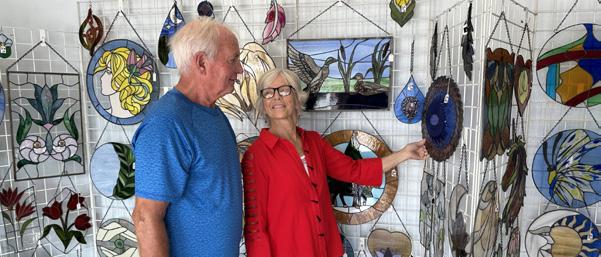


Indiana’s electric cooperatives and their statewide magazine, Indiana Connection, recently named the winners of the 28th annual Cooperative Calendar of Student Art Contest. Presley Gray, an 11th-grade homeschooler from Fort Wayne, has been honored as Artist of the Year for her piece, Autumn Hound. Her skillful use of colored pencils, gel pens, and markers reveals a detailed portrayal of a basset hound gazing up as the last leaves of November fall.
A first-place artist was also selected for each grade, K-12. Each will receive $200. Thirteen additional artists earned an honorable mention award and $75. A complete list of the contest winners is to the right.
"Indiana’s electric cooperatives value the creativity and talent of young people in their
communities," said John Cassady, CEO of Indiana Electric Cooperatives. "This contest is a great way to encourage creative expression while giving students the opportunity to share their work with people across the state. Supporting local students in this way reflects cooperatives’ commitment to the communities they serve.”
Students who enter the art contest are asked to create artwork that illustrates the month that corresponds numerically with their grade at the time they enter the contest. Kindergartners could use whatever their imagination thought up when creating art for the calendar’s cover.
The artwork was judged on artistic merit, originality, creativity, and suitability for a wall calendar. The art contest is open to any Indiana K-12 student.

Kindergarten
Jane Olsen, Newburgh
First grade
Luci Lampert, Birdseye
Second grade
Lacey Madden, Birdseye
Third grade
Nash Cissell, Borden
Fourth grade
Dustin Otto, Amboy
Fifth grade
Hunter Spindler, Greenwood
Sixth grade
Flynn Cissell, Borden
Seventh grade
Isabella Martin, Fort Wayne
Eighth grade
Zoe Bubp, Fort Wayne
Ninth grade
Cooper Baird, Fort Wayne
10th grade
Daelyn Kirkdorffer, South Whitley
11th grade
Presley Gray, Fort Wayne (Best of Show)
12th grade
Cassidy Skinner, South Whitley
Kindergarten
Junia Richey, Milford
First grade
Claire Landis, Georgetown
Second grade
Suzie Shepard, Fort Wayne
Third grade
Viola Fessel, New Albany
Fourth grade
Audrey Katerberg, Madison
Fifth grade
Elise Weaver, West Lafayette
Sixth grade
Ella Jamiel, Syracuse
Seventh grade
Norah Yoder, Fort Wayne
Eighth grade
Reece Shalley, Bloomington
Ninth grade
Marissa Rodgers, Fort Wayne
10th grade
Elle Zeidler, Elizabeth
11th grade
Annalise Nymann, Seymour
12th grade
Riley Aebersold, New Albany





































If you’ve lived in the Midwest for any length of time, you know this section of the country has a reputation for being a place where tornadoes are relatively common, especially in the warmer months. Although tornadoes are more common in the Midwest and the Central Plains, they have been reported in all 50 states.
While it’s helpful to always know the forecast for your area, it’s particularly important during the summer months when severe weather can put lives at risk. Pay attention when the forecast calls for thunderstorms and the potential for severe weather. The following are tips for staying safe no matter where you are when a tornado develops.
Once a tornado watch has been issued for your area, meaning conditions are favorable for them to develop, you want to stay updated with local media or other sources. If you’re at home and a tornado warning is issued, go to your basement or an interior space with no windows or doors to the outside. Take your pets with you.
If you’ve never practiced what to do during severe weather at school or work, now may be a good time to familiarize yourself with safety plans. Where are the
tornado shelters at your workplace? If your company doesn’t have a plan, consider developing one. When a tornado warning is issued, help your co-workers get to a safe place with no windows.
If you are outside during a tornado warning, try to find shelter in a sturdy building. It’s important to remember that sheds, storage facilities, mobile homes, and tents are unsafe during tornado warnings. If no shelter is available, lie flat in a ditch or low-lying area, cover your head with your arms, and get as far away from trees as possible.
If you can’t safely drive to a shelter, pull over, leave the car, and seek refuge in a low-lying area like a ditch. Make sure to cover your head. Do not try to outrun the storm. A vehicle is considered one of the least safe places during a tornado.
You should stay in your safe space until the severe risk has passed your area. Remember, multiple rounds of storms producing tornadoes are possible when severe weather strikes your area. Once the threat has passed, then let family and loved ones know you’re safe.
Chris Adam is a freelance writer from Lafayette. Source: National Weather Service











1 package wonton wraps
1 lb pork sausage
1 red pepper, finely diced
1 green pepper, finely diced
1 cup shredded Mexican cheese or 1 ⁄ 3 cup each of shredded sharp cheddar, mozzarella, and pepper jack
½ cup ranch dressing
Preheat oven to 350 F. Place 24 wonton wraps in two muffin tins. Brush with oil and bake for about 5 minutes or until they are light brown. While the wontons are baking, cook the sausage and drain. Add the peppers, cheese, and ranch to the sausage and stir to combine. Spoon the filling into the baked wontons. Place them back in the oven for 5 to 10 minutes until the cheese is melted and the cups are browned.


Jake Davis, Whitestown
8 oz pasta
1 lb chicken breast, diced
4 slices of bacon, chopped
1 ranch seasoning packet
1 cup spinach
½ cup heavy cream
3 Tbsp ranch dressing
Salt and pepper to taste
Parmesan cheese for topping
Cook the pasta according to the instructions, then drain and set aside. In a large skillet, cook the chopped bacon over medium heat until crispy. Remove bacon and set aside, leaving the drippings in the pan. Add the diced chicken to the skillet and season with salt and pepper. Cook the chicken until it’s browned and cooked through, about 5 to 7 minutes. Stir in the ranch seasoning, ranch dressing, spinach, and heavy cream until well combined. Let it simmer for a couple of minutes until it thickens slightly. Then mix in the cooked pasta and crispy bacon. Stir well to combine and heat through for about 2 minutes. Top with Parmesan cheese and serve warm.
Verna Wagler, Odon
8 to 10 potatoes, peeled or unpeeled, cut into ½-inch cubes
1 lb bacon, fried, drained, and chopped
1 cup ranch dressing
2 cups cheddar cheese, shredded
6 Tbsp butter
1 tsp salt
½ tsp pepper
Preheat oven to 350 F. Boil the potato cubes until soft and drain. In a 9x13 pan, layer half the cooked potatoes and half the bacon. Place a few pats of butter on top, then sprinkle with salt and pepper. Add a layer of ranch dressing and cheese. Repeat the layers. Bake uncovered for 30 minutes or until the cheese is bubbly and melted. Serves 10 to 12.



Illuminating lives one home at a time
BY STEPHANIE BERNABA

Inthe remote Guatemalan mountains along the Mexican border, nearly 200 homes around the village of Palmira were illuminated for the first time as lineworkers from Indiana’s electric cooperatives brought electricity — and hope — through their volunteer mission with Project Indiana.
The trip, which took place between January and February of this year — the team’s sixth since 2012 — brought electricity to communities that have never had access to it.
For the 22 crew members who made the journey, the experience could only be described as transformative.
“It was one of the best things I’ve felt I’ve done with my life so far as giving back to others,” said Paul Trenkamp, a first-time volunteer lineworker from Decatur County REMC.
The initiative’s crew leader, Joe Banfield, operations manager at Tipmont, now a three-time Project Indiana veteran, described the remarkable scale of the team’s achievements.
“We took our first trip to Guatemala in 2012. This last trip was probably one of my most rewarding and probably the hardest, just because of the terrain and the number of people we gave power to,” Banfield said.
What made the 2025 trip most remarkable to him was how greatly the team exceeded its established goals.
“When we first received the information, our goal was 70 homes and 30 poles,” said Banfield. “When we went over to complete the project engineering, the number jumped to 109 homes. By the end, we wound up electrifying 197 homes.”
The villagers’ enthusiastic involvement made this extraordinary achievement possible. Some helped place electric poles, while others learned how to install outlets and light fixtures so modifications could be made once the team returned home.
This spirit of collaboration and gratitude was evident throughout the team’s 18-day stay.
Trenkamp marveled at villagers who walked 20 minutes just to return a dropped screw or piece of wire from a previously wired home. He noted that no villager would let any material go to waste, no matter how small.
“They tracked down where we were, walked 20 minutes over to us, just to hand us back that screw,” said Trenkamp. “That happened a half a dozen times. Despite having almost nothing, they’re some of the happiest people I’ve ever met. They all knew each other and helped one another — and us — without hesitation.”
While bringing electricity was their mission, the Indiana crew found themselves forever changed by the villagers, especially one struggling family whose circumstances stirred them to extraordinary action.
“We ended up meeting a family that was basically orphaned kids, and the head of the household was a 6-yearold girl,” Trenkamp explained.
continued on page 22

continued from page 21
“It hit me right at home, and I felt a lot of compassion for them. So, I made sure we would do something special for them.”
Their situation was grim. After their mother passed away, the oldest boy, around 13 or 14 years old, left home to work in the coffee fields to support his siblings.
“The oldest boy is out working in the coffee field, and the way it sounded, he doesn’t even come home,” Trenkamp said.
Most heartbreaking was the burden placed on the 6-year-old girl who had been thrust into the role of household caretaker in her brother’s absence.
“The grandmother lives across the street,” he explained, “and she’s trying to teach the 6-year-old girl how to maintain a house, cook meals, and clean. She hasn’t even started school yet, and she already has responsibilities that are challenging for some adults.”
The lineworkers, moved by the family’s circumstances, pooled their resources to provide much-needed assistance.
Together, the lineworkers purchased a refrigerator, a gas stove, a table and chairs, and paid the family’s electric bill for a year. They also provided school supplies, including bookbags and uniforms.
Zach Albin, another lineworker from Heartland REMC, took time from his assigned duties to lend a hand.
“I chose to take a break from the line crew for one day so I could go make the table we got them, show them their fridge, and hand out their backpacks,” Albin said. “We wanted to watch them unpack and see all the stuff we got.”
“Being able to give back was amazing,” Trenkamp added. “It made me feel really good about what we were doing.”
The impact was particularly emotional for Albin, who has three young daughters at home.
“It was just rough,” he explained. “They were young — too young to live the way they did. It was a little difficult for me, especially because one looked similar to my middle child. It was difficult for me to fathom my child in that situation.”
The residents’ and lineworkers’ lives have become intertwined like the power lines now linking their village.
“Billy was a 10-year-old kid who showed up on day one or two,” Trenkamp said. “When we were wiring on the inside of the houses, you could drop a screw, and Billy would have it picked up before it hit the ground.”
Billy’s devotion and work ethic impressed the whole crew.
“He was really helpful — 10 years old and grown up beyond his years. I was glad to help give him some advantages for the future. Before we left, I gave him some of the tools I brought to Guatemala with me,” Trenkamp said.
The unexpected bond with Billy, who rapidly became the crew’s most devoted assistant, transcends distance and grows stronger by the day.

“Billy texts and calls about every single day,” Albin shared. “He sends me pictures, and I send him pictures of things back here. It’s just a lot of fun.”
Amanda Barth, vice president of communication for Indiana Electric Cooperatives and executive director for Project Indiana, explained that Project Indiana is about more than electrification — it’s about building sustainable futures.
“We don’t just stop with electrifying a village and building the infrastructure. We try to help them create a better way of life, and we’re best able to do that by focusing our energies and continuing to support them,” Barth said.
Many lineworkers confessed the experience has enriched their worldviews.
“I did want to remind myself often how I take little things for granted, like filtered water and common amenities like air conditioning,” reflected Albin. “I sleep dry and warm every night, but some of those people did not sleep dry, and they were either too warm or freezing. I try not to take those small things for granted anymore.”
Crew leader Joe Banfield also noted a particularly touching moment the day he electrified a 105-year-old woman’s home.
“I was there when she first turned on her light switch. You’ve got to think back for a second — 105 years with no electricity. That is mind-boggling. She turned that light on for the first time, and she started bawling. She’s crying, she’s hugging me. It was very overwhelming.”
continued on page 24

Left to right: Kevin Bay, JCREMC; John Cassady, CEO, Indiana Electric Cooperatives; Andrew Don, CEO, CFC; Carolina Park, Senior Manager, CFC; and Joe Banfield, Operations Manager, Tipmont
Project Indiana’s trips to Guatemala would not be possible without the support of the National Rural Utilities Cooperative Finance Corporation (CFC). Since 2017, CFC and National Cooperative Services Corporation (NCSC) have helped finance 30 international electrification projects undertaken by 18 states. Over the years, CFC and NCSC have contributed more than $2 million in support of those missions.
“We are very grateful for CFC’s support of Project Indiana,” said Amanda Barth, executive director for Project Indiana. “CFC’s support helped ease the financial burden on our member cooperatives in a tough economic climate for the industry. CFC’s grant assisted with purchasing the supplies, crew member hotel rooms and meals in Guatemala, rental vehicles, and many other things.”
Barth noted the other very valuable component of CFC’s participation in this project was having the expertise of CFC CEO Andrew Don and CFC Senior Manager of Financial Tools and Analysis Carolina Park on the trip. Park also serves as a Project Indiana board member.
Coopeffa R.L. is the small, local cooperative utility that serves Palmira. While in Guatemala, Don and Park met with Coopeffa R.L.’s board and staff to counsel them on the cooperative business model and how to make the most of that model in operating their small utility. They also met with Guatemalan dignitaries, including the minister of energy, to express their support for using the cooperative business model in electrifying the rest of the country.
“We want to support our member electric cooperatives to undertake these international projects,” Don said. “It’s a big endeavor putting a project like this together. They just need a little financial help. It’s the sixth cooperative principle: Cooperation Among Cooperatives. And helping communities like the village of Palmira is also very important. It made a big impact on me to visit the village and see similar situations to what many rural Americans probably faced 90 years ago.”
While electrifying the village was the primary goal, that was not the only benefit.
“Electricity brings economic prosperity,” Don explained. “With electricity, you can create a better way of life. For the lineworkers, they’re able to see how it’s making a huge difference in somebody’s life. That was one of the biggest takeaways for me, seeing how the experience resonated with them.”
“The line crews were very proud and happy to be there,” said Park. “They were not only putting up the lines and bringing electricity; they really engaged with the community. I knew this experience would not only change lives in the community but change our and the linemen’s perspectives as well.”
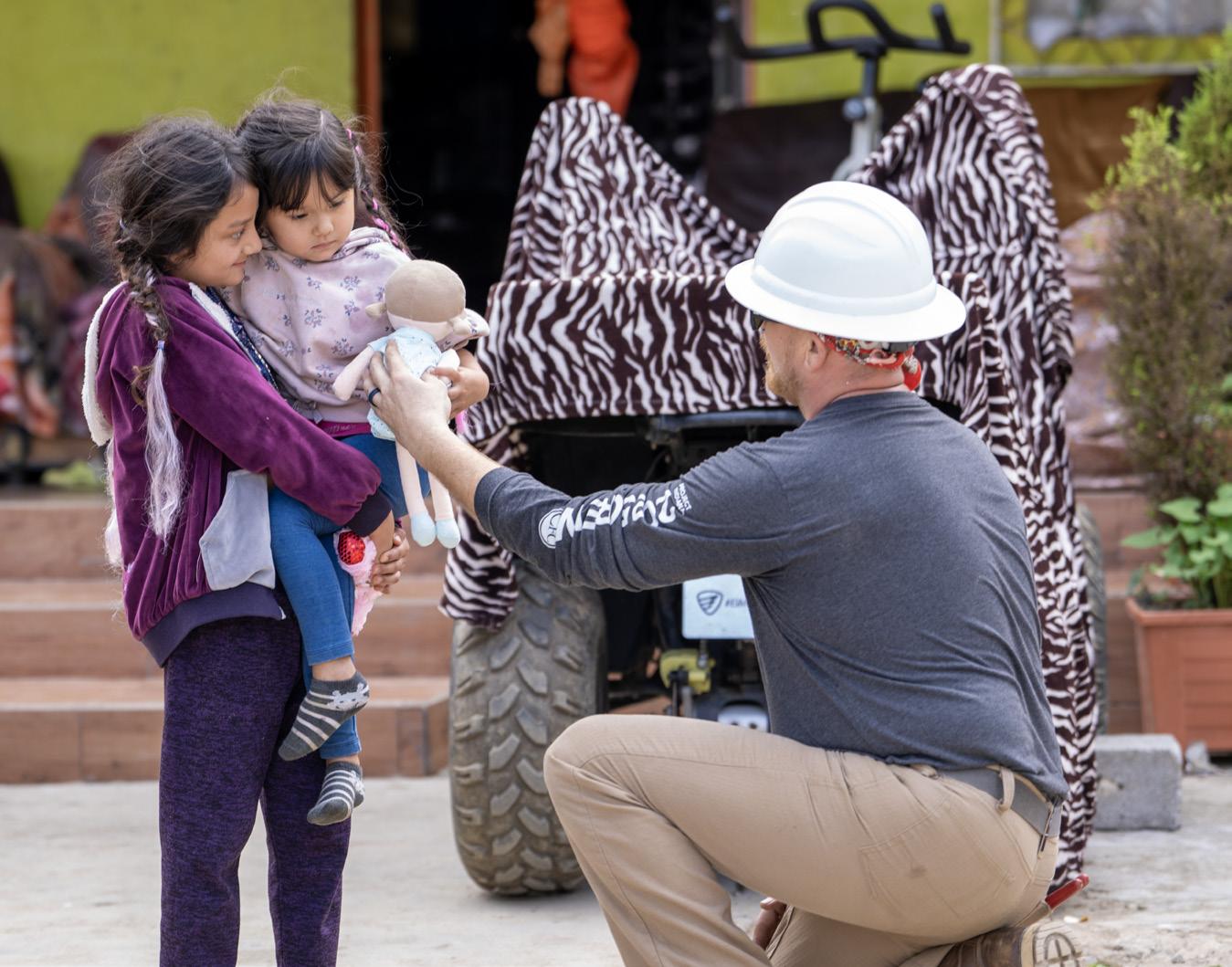


continued from page 23
Project Indiana transcends typical charity work — it’s a true partnership in which local communities actively shape their own futures alongside American volunteers.
Project Indiana thrives on partnerships — from Milwaukee Tools’ significant equipment donations to National Rural Utilities Cooperative Finance Corporation’s (CFC) crucial financial backing — but its invaluable work requires ongoing support to brighten Guatemala’s remote highlands.
“We’re not giving them a handout, we’re giving them a hand up, and they are working alongside our guys the entire time,” Barth emphasized. “We have people from that village working with our guys every step of the way because they are personally invested in this as well. They look forward to our trips and helping out the teams.”
For the lineworkers who volunteered their time, Project Indiana offers an opportunity to use their specialized skills to significantly improve the villagers’ lives.
As Project Indiana continues its mission, the impact ripples far beyond the electrification of homes.
“The companies and people that support Project Indiana,” Albin said, “I urge them to continue so we can do these trips. Our trip alone changed the lives of 200 families.”
Project Indiana depends on corporate and individual supporters to accomplish its mission of empowering global communities one village at a time. To learn more about Project Indiana and donate to the program, visit projectindiana.org/support
Zach Albin, of Heartland REMC, prepares to frame a pole while

Jonah Brewer, Bartholomew County REMC
Bo Simpson, Clark County REMC
Collin Crabtree, Decatur County REMC
Paul Trenkamp, Decatur County REMC
Garret Berg, Dubois REC, Inc.
Steve Saltsgaver, Harrison REMC
Zach Albin, Heartland REMC
Kevin Bay, JCREMC
Kolbie Cox, Miami-Cass REMC
Brandon Bambusch, Orange County REMC
Terry Minic, Paulding Putnam Electric Cooperative, Inc.
Jaylin Brown, RushShelby Energy
Cody Campbell, South Central Indiana REMC
Dakota Grimes, South Central Indiana REMC
Jimmy Applegate, Southern Indiana Power
Matt Bassett, Tipmont
Robert White, Indiana Electric Cooperatives
Joe Banfield, Tipmont
Chris Todd, Northeastern REMC
Ron Holcomb, Tipmont
Eric Jung, Northeastern REMC Joe Bower





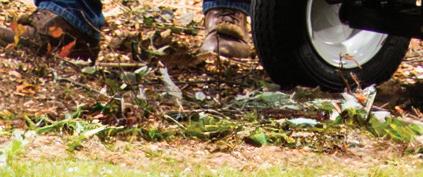
































































































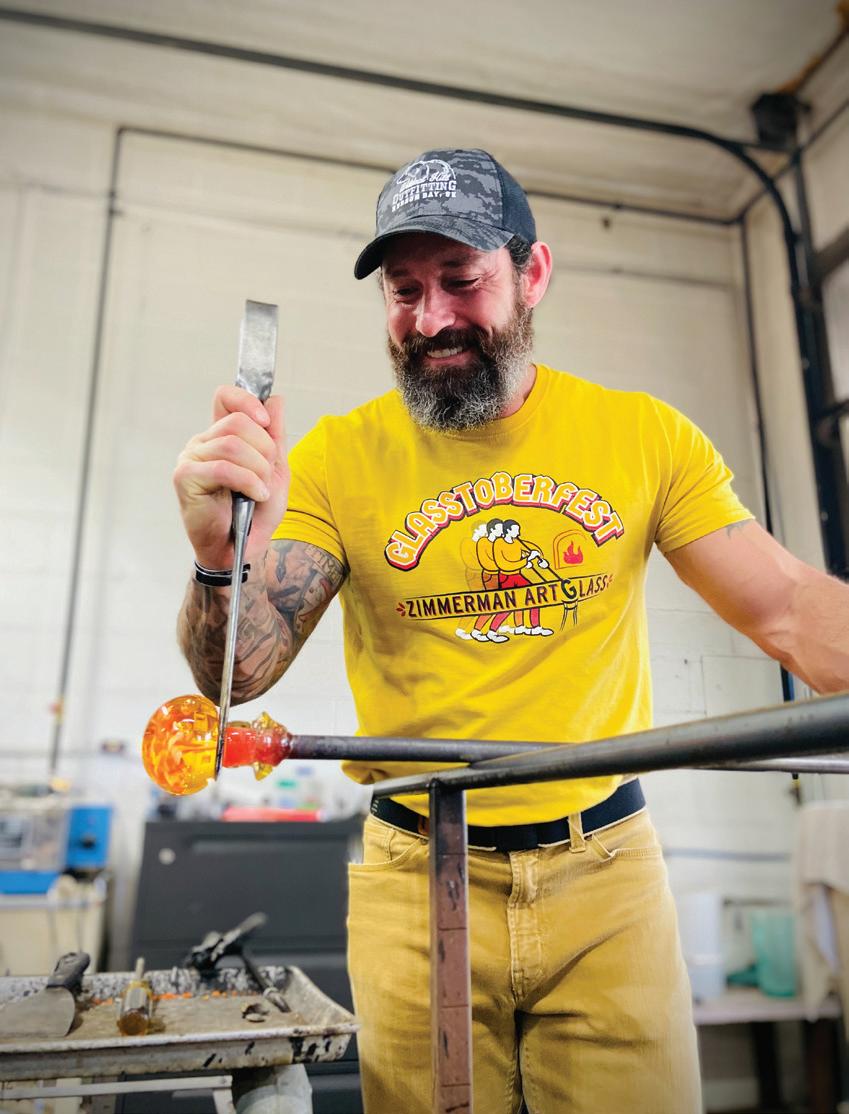


If the question is whether good things come in small packages or perhaps small buildings, Kerry Zimmerman might smile slyly and reply, “Come with me over here,” and he would show you that they do. It happened that way once, he said, when a man appeared disappointed after he arrived at Zimmerman Art Glass, repurposed from a former gas station in downtown Corydon, and asked, “This is it?”
The dubious visitor was surprised when he was guided around and given a demonstration, said Zimmerman, and had left impressed. “It’s that personal connection that’s so important, that we really value.”


Zimmerman is a fourth-generation glassblower from a family that immigrated from France in the 1880s. Ferdinand Zimmerman began his journey into mass-production glass by making punch bowl sets in a Pittsburg, Pennsylvania, factory. In the early 1920s, the second generation of the Zimmerman family moved to Corydon and continued the glassblowing business.
With a strong local and online presence in videos and social media, Zimmerman and his sons, Brian and Alex, aim to make that personal connection often.
Multiple times a year, busloads of students and tourists visit the shop, in addition to individuals, local groups, and attendees of the twoday Glasstober Festival in October.
These events give Zimmerman the opportunity to recite his demonstration talk upwards of 600 times a year. During the Christmas season, Zimmerman offers signups for one-on-one experiences for people to create their own glass ornaments under his family’s expert guidance.
While needs and tastes for glass products have changed over the generations, Zimmerman said many things about their creation, including tools and certain techniques, have stayed the same. “It’s art,” he said, “but it’s functional art.”
Their showroom and images on their website showcase their beautiful creations. They offer vases, handled dishes, paperweights, bottles, bowls, pitchers, and glasses, as well as memorial items that can incorporate a loved one’s ashes. Custom etching is available, and glass items can be made in a wide variety of colors. Whimsical pieces include flowers, animals, fruit, and an annual specialty item for various Indiana landmarks.
The family’s craft and legacy stretch beyond its current physical footprint. But what matters most for Zimmerman is the link to people. “Even though we just met, or when I’m looking at your order,” he said, “I’m making that just for you.”
Veni Fields is a journalist and freelance writer from Virginia Beach.

For most people, their electricity provider is just the company that keeps the lights on. But an electric cooperative’s relationship with its member-owners is different. Since the 1930s when Indiana’s electric cooperatives were formed, they have thrived because of the political engagement between their members and local, state, and federal governments.
Indiana’s electric cooperatives advocate for rural Hoosiers like you on the state and federal levels so they can continue providing safe, reliable, and affordable energy — and maintain the quality of life in rural communities. But electric cooperative members need to participate in the process, too. Indiana’s electric cooperatives thrive when their members stay politically engaged and advocate for policies that help cooperatives.
How can you help do this? It all starts with grassroots activism. In the
context of the electric cooperative program, “grassroots” is a powerful word. In fact, the historical success of the electric cooperatives can be largely credited to that single word.
The electric cooperative definition of “grassroots” is “electric cooperative activists — directors, managers, employees, and members — who take an active role in the political process to protect their cooperative from harmful legislation and regulation, as well as to promote the value of cooperative ownership to their legislators.”
Grassroots involvement means communicating with local, state, and federal legislators on issues affecting electric cooperatives.
Grassroots — the unified efforts and voices of the nation’s electric co-op supporters — has proven to be the foundation of the industry’s 85 years of success in serving electric co-ops, their owners, and their communities.
What does a grassroots advocate do?
By registering as an advocate for Indiana’s electric cooperatives, you will be kept up to date on major legislative and political utility issues, at both the state and federal levels. You will receive monthly communication via email or text alert, ranging from educational pieces, surveys, story collections, and even calls to action.
Grassroots advocates for Indiana’s electric cooperatives help keep rural Indiana strong and the cooperative voice heard. Advocates may also be called upon to contact their legislators and speak up for Indiana’s electric cooperatives.
As a grassroots advocate, you will be on the front lines of keeping rural Hoosiers’ voices loud and strong.
To become a grassroots advocate for Indiana’s electric cooperatives, visit action.indianaec.org
Hoosier Energy’s Pipkin and Sowders work to advance local communities

Nearly every day, the Hoosier Energy economic development team is answering questions.

But Economic Development Manager Jeff Pipkin wasn’t satisfied with questions from member cooperatives, member consumers, or other local government and economic leaders.
Over the past three years, Pipkin has taken classes with the Midwest Community Development Institute and recently answered many more questions to pass the exam to become a Professional Community and Economic Developer.
“It’s always been a professional goal of mine to get a certification,” Pipkin said. “Community development is more focused on the foundation of a community to accept industrial development or economic development. You’re looking at the quality of a place, you’re looking at housing, and you’re looking at developing your government assets so they can work as efficiently as
possible while making sure parts of the community are not being left behind.”
That certainly fits with the work Pipkin and fellow Economic Development Manager Jeremy Sowders do. They’re involved in projects that could impact Hoosier Energy and its member cooperatives, as well as the towns and counties in and around those territories.
Pipkin sits on the economic development boards in Lawrence County and Greene County and is the Board President for Radius Indiana, an economic development organization for the eight-county region of Crawford, Daviess, Dubois, Greene, Lawrence, Martin, Orange, and Washington.

Sowders is on the economic development board in Owen County, a board member for the Bloomington Economic Development Corporation, and serves on the boards for the I-74 Business Corridor and Accelerate West Central
Indiana Economic Development. He is also an accredited Certified Economic Developer through the International Economic Development Council (IEDC).
“One of our department’s focuses is constantly working with our local economic development organizations within our members’ territory,” Pipkin said. “Our local economic development organizations are contacting us regularly, asking for advice on how to tackle some of the issues they face on a daily basis.”
Those issues range from financing to site development and learning how to take advantage of things like the USDA Rural Economic Development Loan and Grant (REDLG) program. One such approval out of that program is a health clinic in Connorsville, just outside of Whitewater Valley REMC territory but located where it will benefit its members.
“We have a good knowledge of what’s going on in the entirety of Hoosier Energy territory, and we try to work together as much as possible,” Pipkin said.
ASSETS (What We Own)
lIAbIlITIES (What We Owe)
Some of my best memories go back to the warm spring days I spent with my mother in the woods. The youngest of three children, I loved those grand expeditions as we headed out the backdoor into a leafy stand of poplar, beech, and oak. Late April and early May meant leaving our quiet house in midmornings carrying sandwiches wrapped in waxed paper, my jeans patched, my “Red Ball Jets” doubleknotted, and a battered canteen of cold water over my shoulder.
My mother loved the woods and wanted me to love them too, but at that time of year, it was more than lessons in appreciation for nature or a bit of exercise she had in mind — we were there to hunt mushrooms. The sun on my arms, the fresh air, the brilliant color of redbud and dogwood blooms, the rich aromas of last year’s leaves, and the new spring’s soil were mere bonuses.
For someone so keen on finding mushrooms, even now, I have never acquired a taste for them. Whether they be the black morels that appear first in the month-long season or the “goosenecks” that come along after, the highly-prized white and yellow morels that spring up next, or the smaller “tulips” that hide as the Dutchman’s Breeches and wood anemones take over the forest floor, I have always found my joy from the finding rather than the eating.
In those days, I usually found the firmer gray-blacks along one particular wash, the fiddlehead ferns there a foot tall by the time I scrabbled along its banks. Every second or third year we
found big yellow morels, bread sacks of them, as they poked up through the leaf litter below a carpet of Mayapples in a flatland that tumbled toward rich farm fields.
But, most of all, I remember the tiny and often sunburned tulip morels that I pinched off at the ground by the dozens in a scrubby meadow that stretched out for an acre or more near my family’s small peach and apple orchard. It was there that I was first left to search alone.
Now, it’s my grandsons who hunt with me, and not unlike my childhood days, we walk out the backdoor of our house into a woodland, this one of black cherry, sugar maple, and sycamore. It is a place for adventures, one of steep hills and deep ravines, with a shallow pond and reedy marsh teeming with skunk cabbage, horsetails, and dragonflies.
I use a walking stick now, useful for pointing and turning leaves and making paths through stands of blackberry and wild rose thorns. To be sure, we find mushrooms, and over these past few springs — as they’ve grown taller and I’ve grown slower — we’ve found even more. Not just the wild ginger near the clearing where the old power line ran, the box turtles living in the glade near the abandoned railroad bed, or the warblers and robins that scatter in our chattering wake.
We have grown closer as we walk the woods, and hopefully, they will remember the green spring days of their childhoods as I have remembered mine.


Mike Lunsford is a freelance columnist, feature writer, and photographer, primarily for the Terre Haute TribuneStar and Terre Haute Living magazine. The author of seven books lives in Parke County with his wife, Joanie. Contact Lunsford at hickory913@gmail.com.
Halfa mile beneath the icy waters off the coast of Argentina lives one of the most remarkable creatures in the world.
Fully grown, they’re less than 2 feet long and weigh under 10 pounds…
But despite their small size, this strange little squid can have a bigger positive impact on your brain health than any other species on the planet.
They are the single richest source of a vital “brain food” that 250 million Americans are starving for, according to a study published in the British Medical Journal.
It’s a safe, natural compound called DHA – one of the building blocks of your brain. It helps children grow their brains significantly bigger during development. And in adults, it protects brain cells from dying as they get older.
Because DHA is so important, lacking enough of it is not only dangerous to your overall health but could be directly related to your brain shrinking with age.
With more than 16 million Americans suffering from ageassociated cognitive impairment, it’s clear to a top US doctor that’s where the problem lies.
Regenerative medicine specialist Dr. Al Sears, says thankfully, “there’s still hope for seniors. Getting more of this vital brain food can make a life changing difference for your mental clarity, focus, and memory.”
Dr. Sears, a highly-acclaimed, board-certified doctor— who has published more than 500 studies and written 4 bestselling books — says we should be able to get enough DHA in our diets… but we don’t anymore.
“For thousands of years, fish were a great natural source of DHA. But due to industrial fish farming practices, the fish we eat and the fish oils you see at the store are no longer as nutrient-dense as they once were,” he explains.
DHA is backed by hundreds of studies for supporting razor sharp focus, extraordinary mental clarity, and a lightning quick memory… especially in seniors.
So, if you’re struggling with
focus, mental clarity, or memory as you get older…
Dr. Sears recommends a different approach.
Research has shown that our paleo ancestors were able to grow bigger and smarter brains by eating foods rich in one ingredient — DHA.
“Our hippocampus thrives off DHA and grows because of it,” explains Dr. Sears. “Without DHA, our brains would shrink, and our memories would quickly fade.”
A groundbreaking study from the University of Alberta confirmed this. Animals given a diet rich in DHA saw a 29% boost in their hippocampus — the part of the brain responsible for learning and memory. As a result, these animals became smarter.
Another study on more than 1,500 seniors found that those whose brains were deficient in DHA had significantly smaller brains — a characteristic of accelerated aging and weakened memory.
Dr. Sears uncovered that sometime during the 1990s, fish farmers stopped giving their animals a natural, DHA-rich diet and began feeding them a diet that was 70% vegetarian.
“It became expensive for farmers to feed fish what they’d eat in the wild,” explains Dr. Sears. “But in order to produce DHA, fish need to eat a natural, marine diet, like the one they’d eat in the wild.”
“Since fish farmers are depriving these animals of their natural diet, DHA is almost nonexistent in the oils they produce.”
“And since more than 80% of fish oil comes from farms, it’s no wonder the country is experiencing a memory crisis. Most people’s brains are shrinking and they don’t even know it.”
So, what can people do to improve their memory and brain function in the most effective way possible?

MEMORY-RESTORING SENSATION: The memory-saving oil in this Antarctic squid restores decades of lost brain power starting in just 24 hours.
Dr. Sears says, “Find a quality DHA supplement that doesn’t come from a farmed source. That will protect your brain cells and the functions they serve well into old age.”
Dr. Sears and his team worked tirelessly for over 2 years developing a unique brain-boosting formula called Omega Rejuvenol. It’s made from the most powerful source of DHA in the ocean, squid and krill — two species that cannot be farmed.
According to Dr. Sears, these are the purest and most potent sources of DHA in the world, because they haven’t been tampered with. “Omega Rejuvenol is sourced from the most sustainable fishery in Antarctica. You won’t find this oil in any stores.”
Already, the formula has sold more than 850,000 bottles. And for a good reason, too. Satisfied customers can’t stop raving about the memory-boosting benefits of quality-sourced DHA oil.
“The first time I took it, I was amazed. The brain fog I struggled with for years was gone within 24 hours. The next day, I woke up with the energy and mental clarity of a new man,” says Owen R.
“I remember what it was like before I started taking Omega Rejuvenol… the lack of focus… the dull moods… the slippery memory… but now my mind is as clear as it’s ever been,” says Estelle H.
“My mood and focus are at an
all-time high. I’ve always had trouble concentrating, and now I think I know why,” raves Bernice J. “The difference that Omega Rejuvenol makes couldn’t be more noticeable.”
And 70-year-old Mark K. says, “My focus and memory are back to age-30 levels.”
These are just a handful of the thousands of reviews Dr. Sears regularly receives thanks to his breakthrough memory formula, Omega Rejuvenol
To secure bottles of this brainbooster, buyers should contact the Sears Health Hotline at 1-888-3588160. “It takes time to manufacture these bottles,” says Dr. Sears. “The Hotline allows us to ship the product directly to customers who need it most.”
Dr. Sears feels so strongly about this product, he is offering a 100%, money-back guarantee on every order. “Send back any used or unused bottles within 90 days and I’ll rush you a refund,” says Dr. Sears.
The Hotline is taking orders for the next 48 hours. After that, the phone number may be shut down to allow for inventory restocking. Call 1-888-358-8160 to secure your limited supply of Omega Rejuvenol. Readers of this publication immediately qualify for a steep discount, but supplies are limited. To take advantage of this great offer use Promo Code ICOM525 when you call.
